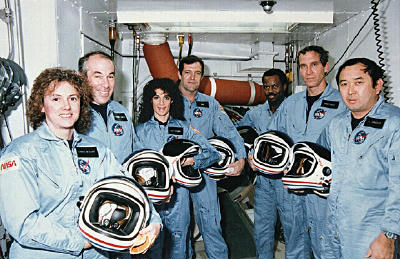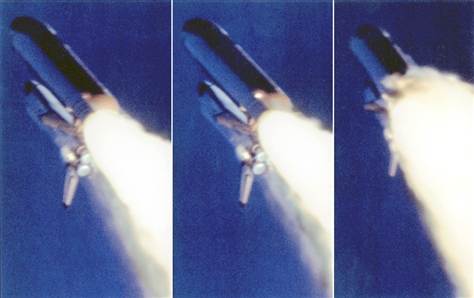“We risk great peril if we kill off this spirit of adventure, for we cannot predict how and in what seemingly unrelated fields it will manifest itself. A nation that loses its forward thrust is in danger, and one of the most effective ways to retain that thrust is to keep exploring possibilities. The sense of exploration is intimately bound up with human resolve, and for a nation to believe that it is still committed to a forward motion is to ensure its continuance.” James A. Michener 1979
It is still hard to believe. But then Space Shuttles don’t blow up every day, but the Space Shuttle Challenger just beginning mission STS-51L on that cold and sunny Florida morning.
Challenger’s crew
I guess that events like the explosion of Challenger remain with those that viewed them because they were unusual, historic and most of all, tragic. Yes we remember events of triumph as well, and they too make an imprint on our memories, but tragedies that impact a nation and the world touch us in a different and often more powerful way. I think this is because they expose to us our own mortality and vulnerability to things that we cannot control.
I know that I, like many others of my generation had grown up with the triumphs of the NASA manned space program. We had seen the incredible success of the Mercury, Gemini and Apollo programs. Success and triumph were associated with the program. Even the tragic fire which consumed the command module of the Apollo I mission on January 27th 1967 during a launch pad test killing Astronauts Gus Grissom, Edward White and Roger Chaffee did little to quench our belief in the program.
In 1972 as the Apollo program wound down a new program was developed to be a more affordable means to continue space travel and scientific study. The program became the Space Shuttle program built around reusable orbiters of which Challenger was the third built for the program.
By the time Challenger was being prepared for STS-51-L we had become to Shuttle missions being routine. NASA was launching a mission every two to three months. Challenger was the second of two missions in January 1986, her sister Columbia having returned from a 6 day mission just 10 days before her launch.
This familiarity with the routine of the Shuttle program and expectation of success made many of us forget that space travel is inherently dangerous and that complex vehicles like the Shuttle were not indestructible.
The STS-51-L mission was to be the 10th for the Challenger in under three years of service. The mission had been delayed due to weather on the 22nd and rescheduled several times due to weather or in one case due to problems with an exterior access hatch.
Challenger takes off on January 28th 1986
The morning of the launch the weather was predicted to be at or below the 31 degree minimum safe launch threshold. Engineers from the builder of the Challenger’s Solid Rocket Boosters (SRBs) Morton Thiokol contacted NASA with their concerns that the O-Rings which sealed the joints on the SRBs which they believed might not seal properly. NASA engineers argued that even if the primary O-Ring failed that the secondary O-Ring would be sufficient even though this was an unproven theory. Eventually Thiokol management overruled their engineers influenced by NASA management which demanded that Thiokol prove that it was not safe to launch rather than prove that it was safe to launch. Considering it was a “Criticality 1” component meaning that there was no backup in case of a failure of both joints. It was a clear violation of protocol but the later Rogers Commission would show that NASA managers frequently ignored or evaded safety regulations to meet their very ambitious mission schedule. This decision doomed Challenger and her crew of seven.
On the 28th of January 1986 I was a young commander of the 557th Medical Company (Ambulance) in Wiesbaden Germany. I had heard about the scheduled launch of the Shuttle but paid it little regard, despite the presence if Christa McAuliffe, the first “teacher in space.” That evening was hoping to close out the day by 7PM which was early for me as well as most officers in the 68th Medical Group and 3rd Support Command of what we commonly called the Imperial Army on the Rhine, the US Army Europe.
I had a stack of work in my inbox, NCO evaluations, criminal investigations, maintenance reports and upcoming missions, not to mention trying to get a head start on my Unit Status Report. Most of my soldiers except those on duty had finished for the day.
Challenger’s last moments
About 20 minutes to Six my senior duty person at the company, the Charge of Quarters or CQ in Army parlance came to my door which was at the far end of the hallway from where the CQ was stationed. Specialist Lisa Daley was a solid medic and outstanding soldier who had a great personality that caused her to be well liked in the company. She came to my door and blurted out “Lieutenant Dundas! The Space Shuttle just blew up!”
I looked up from my desk and I remember my words to this day. “Specialist Daley, Space Shuttles don’t blow up.” She then said, “No sir they do, it’s on TV right now!”
I was stunned by her pronouncement. I got up and followed her as she told me what had happened. While I reached the CQ desk I saw the small television which she and her assistant CQ were watching. There was a live feed from CNN replaying the disaster, the twin plumes of smoke careening across the screen marking the spot where 73 seconds into the flight Challenger exploded. I stood there in shock, the images of the divergent plumes of smoke being etched into my mind.
Atlantis landing on her final mission
It is hard to forget. 17 years later I was waiting for the arrival of General Peter Pace, then the Vice Chairman of the Joint Chiefs of Staff to arrive at Naval Station Mayport Florida for the Battle of Hue City Memorial weekend hosted by the USS HUE CITY. I got to the ship early and while drinking coffee in the Wardroom saw the news of the breakup of the Space Shuttle Columbia. It brought back the images of the Challenger disaster. General Pace was delayed as the Joint Chiefs and National Security Council held an emergency meeting and arrived several hours late and when he arrived he spoke of the Challenger disaster along with the Columbia.
The Shuttle program ended with the final mission of the Shuttle Atlantis in July 2011. As one that still dreams of the stars and manned space exploration I do hope that NASA is able to return to manned space missions and go beyond what we have done before. I hope that future programs including the Orion program and maybe manned missions to Mars and beyond can fulfill that ever hopeful opening dialogue of Star Trek: “to explore strange new worlds, to seek out new life and new civilizations, to boldly go where no man has gone before.”
Peace
Padre Steve+







